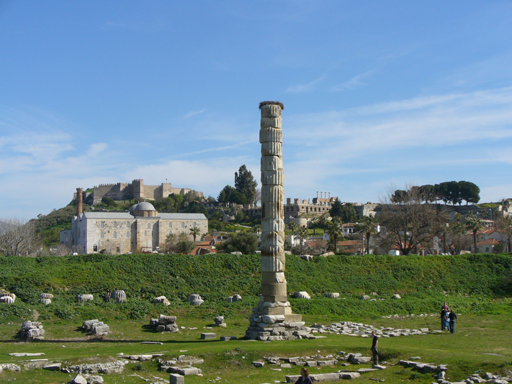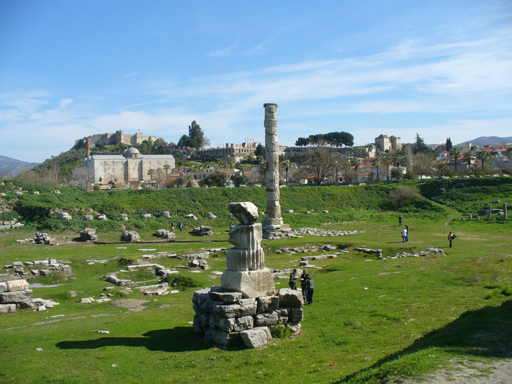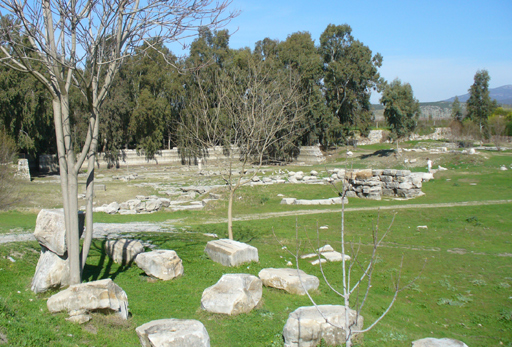History
About 560 BC the Ephesians, with donations from King Croesus of Lydia began construction on a monumental marble temple approximately 185 feet wide. Its length is unknown, although it has been estimated at approximately 378 feet. The temple, the largest structure at the time to be built solely of marble, had double rows of columns, eight rows on the front and back and approximately twenty on the sides. The columns, which supported covered porticoes, surrounded the inner chamber or cella of the temple, which was unroofed. Inside the cella was small building that contained the cult statue. During the 5th century an altar with a large courtyard surrounding it was constructed west of the temple.
The Croesus temple suffered a disastrous fire in 356 BC, set by a man named Herostratus who allegedly wanted to make himself famous. A few decades later, the temple was rebuilt. Alexander the Great, who reportedly was born on the same night of the fire, offered to pay for the construction of the temple, but his offer was diplomatically declined. The new temple, built on the foundations of the Croesus temple, had basically the same dimensions as the earlier temple, although its plan was slightly altered. Built on a thirteen-step platform to avoid flooding, the temple had three rows of eight columns in the front and three rows of nine columns in the rear. The two sides likely had two rows of twenty-one columns each, approximately 59 feet tall. As in the Croesus temple, the Hellenistic temple contained a cult statue of Artemis in the cella of the temple. The U-shaped altar to the west of the temple apparently was rebuilt on the same foundations as the earlier altar.
During Roman times the temple suffered at the hands of people who robbed it of some of its treasures, although Emperor Titus provided major repairs to the temple. In 263 AD the temple was plundered by the Goths, and during Byzantine times it was abandoned with the rise of Christianity. During the 5th century a church was built in the Artemision. Eventually this once magnificent structure succumbed to neglect and pilferage, as some of its materials were reused in other structures. A visit to the site today is rather disappointing. Not much remains to be seen. A lone column, erected from various column pieces, stands on the site. (The reerected column is approximately 13 feet shorter than the original columns.) Much of the earlier excavated areas have been reburied.
 An artist's conception of what the Temple of Artemis may have looked like.
An artist's conception of what the Temple of Artemis may have looked like.
 It is hard to imagine that this was once the site of one of the Seven Wonders of the World. A column assembled from fragments marks the site of the Temple of Artemis here.
It is hard to imagine that this was once the site of one of the Seven Wonders of the World. A column assembled from fragments marks the site of the Temple of Artemis here.
 Another view of the area.
Another view of the area.


A telephoto shot shows a mosque in the left background, the 6th-century Byzantine citadel above it and the site of the Basilica of Saint John (with the pillars) to the right. After the Temple of Artemis had been destroyed by the Goths in 262 CE, its stones were hauled up the hill and used to build the basilica in the 500s CE. Then, after that was destroyed, the stones were hauled back down the hill to build the Isa Bey Mosque — so those stones are now part of their third religious structure over a period of more than 2500 years!
 The statue of Artemis is not here but a 2nd century AD statue is in the Ephesus Museum. The Greek goddess Artemis (known to the Romans as Diana) was the huntress goddess, twin of Apollo.
The statue of Artemis is not here but a 2nd century AD statue is in the Ephesus Museum. The Greek goddess Artemis (known to the Romans as Diana) was the huntress goddess, twin of Apollo.
There is a claim that the cult image was a meteor, or was a statue carved from a meteor. However, this is a common origin myth, and this is mainly known from the otherwise uncorroborated Acts 19:35:
"The city clerk quieted the crowd and said, 'Men of Ephesus, doesn't all the world know that the city of Ephesus is the guardian of the temple of the great Artemis and of her image, which fell from heaven?"There was a close connection between the worship of Artemis and magic, and Ephesus gained a reputation as a center for the magical arts (see Acts 19:17-20) A major industry had grown up around providing shrines and statues of Artemis. As a result of Paul's visit, this industry was being damaged because so many people were becoming followers of Christ. A silversmith called Demetrius stirred up the craftsmen, leading to a riot.
Next we go to the Ephesus Museum.
